Not all of us purchase grown clownfish. Some people choose to buy baby clownfish or clownfish fry. And the trouble with getting the small ones is that you can’t be sure how big they will grow. But how fast do clownfish grow?
An average clownfish grows about 4.5-6 inches in a year or two. But there are various types of clownfish with different growth rates. So you cannot expect the same growth from all clownfish.
I was curious about clownfish growth, and it led me to do some research. And I am glad that I did it because it turned out to be very informative.
How Big Do Clownfish Grow?
Not every clownfish has the same growing size. Some will grow up to 4-4.5 inches, while others can grow as big as 6 inches. It all depends on which clownfish species it belongs to.
But the average size of a clownfish is 4-5 inches. You will find that most of the clownfish, including the Percula and Ocellaris, grow up to 5 inches. However, the Maroon clownfish species is the largest of all and can be 7 inches in size.
That’s why experts always suggest purchasing a fish tank that will give the clownfish enough room to move if it grows more than your expectations. So, what tank size should you get? I will say a 30-gallon tank is more suitable than smaller ones.
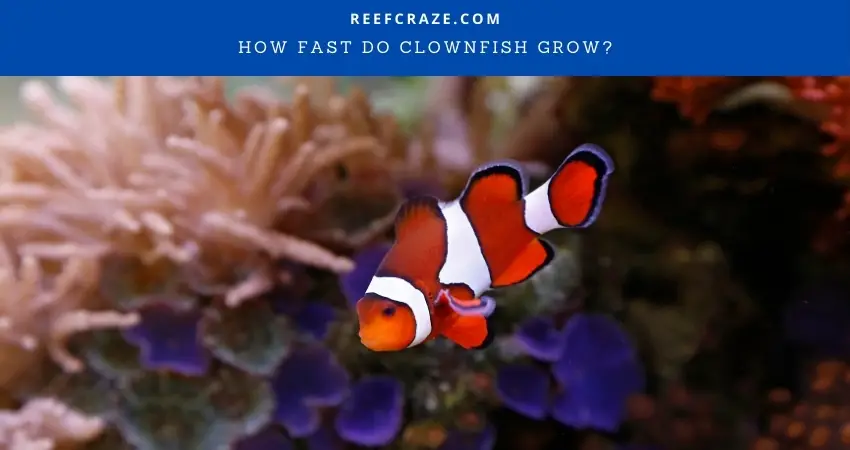
How Fast Do Clownfish Grow?
Clownfish do not grow very big like other typical fishes. They grow up to 6-6.5 inches, but they grow slowly.
Clownfish grow around one inch a year. An average clownfish takes 2-4 years to mature fully, while a 6 inches clownfish takes at least 5-6 years.
And it takes at least half a year or one year for a clownfish to reach maturity. The growing rate of clownfish depends on its type, surroundings, and food habits.
Clownfish Growth By Type
As I mentioned a few times already, the clownfish growth rate can vary based on their types. To help you understand the differences better, here I have described how fast each type of clownfish grows.
Ocellaris
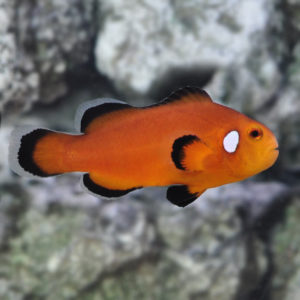
Of all the 30 species of clownfish, Ocellaris are most commonly available. That’s why these fish are called Common Clownfish. This saltwater fish is easy to maintain and breed.
Most Ocellaris grow 3-4 inches, but some of them grow up to 4.3 inches. During the first year, they will grow about half an inch. And then they will grow up to one inch the following year.
Tomato Complex
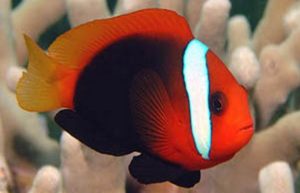
Tomato clownfish are native to the Western Pacific. These fish are larger than the common clownfish or Ocellaris. This fish may look like an adorable little thing, but it can be aggressive sometimes.
Tomato complex clownfish are orange in color and have a long white line near their heads. These fish grow one inch per year and can grow up to 5-5.5 inches.
Cinnamon Clownfish
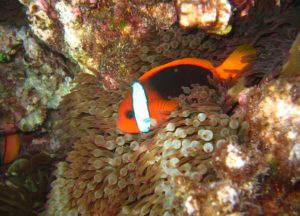
Though the cinnamon clownfish belongs to the tomato complex, these fish have a different growth rate. This fish usually has a dark orange body with mahogany sides. Cinnamon clownfish grow up to 4.7 inches. And their growth rate is one inch or more per year.
Clarkii
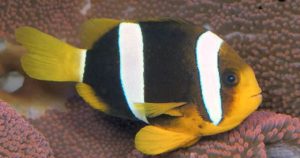
Clarkii clownfish are among the small ones yet pretty bold when it comes to color. This fish is found in the Pacific Ocean. They have a bright yellow body with white stripes and black outlines. Clarkii fish grow up to 4 inches, and they grow half to one inch every year.
Darwin Clownfish
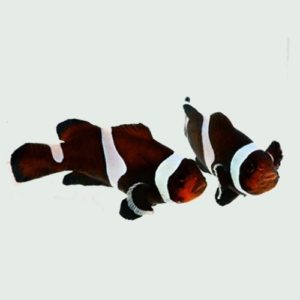
Ocellaris clownfish has variants, and one of them is the Darwin clownfish. This fish does have a similar color pattern to common clownfish. However, their color is black with white stripes.
Darwin clownfish are among the smallest and measure only 3 inches. They grow around half to one inch a year. And it takes them 2-3 years to fully mature.
Maroon Complex
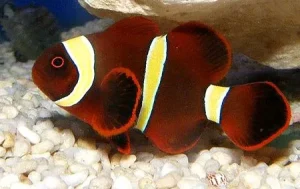
Now it’s time to introduce the largest clownfish type. The maroon clownfish are the biggest and the most aggressive of all clownfish.
This fish has a dark maroon body with vertical white lines and can grow as much as 7 inches. They grow one inch per year, and it takes 6-7 years for the fish to mature fully.
Factors That Influences Clownfish Grow
A common clownfish grows 4.3 inches, whereas a maroon clownfish grows 6-7 inches. What makes such a difference even though they belong to the same fish category? Here are some factors that influence the growth of clownfish.
Food
Food plays the most significant role when it comes to growth. Whether the clownfish is living in the wild or your fish tank, it will grow well if it gets enough healthy food.
Clownfish are omnivores, yet they will need meaty food from time to time. If such food is absent from their diet, it can impact the clownfish’s growth.
Tank Size
The size is the second most essential thing that influences clownfish growth. As you know, clownfish come from the vast ocean. So keeping them in a small tank can hamper their growth as such tanks have low oxygen space and higher nitrates.
Water Condition
Clownfish live in the warmer part of the saltwater ocean. Freshwater sources or tanks are not suitable for them. And if they are to live in a tank, the water temperature has to be warm enough for them.
Even the pH level and ammonia have to be balanced. Without a healthy water condition, the fish’s immunity will become weak and affect their growth.
Maturity
Clownfish do not mature without reaching their full size. Even though it is a slow process, the fish grows and mates with another fish.
As the clownfish grows, it turns into either male or female. If it remains small or does not grow at its usual rate, mating and breeding will not occur.
Health Conditions
A healthy clownfish grows faster. But if you do not maintain the factors mentioned above, it will severely affect the fish’s health. Such things can lead to various diseases that can lead to death.
Anemones
Most people believe that anemones play a significant role in a clownfish’s growth and longevity. That is almost a myth.
Anemones do help clownfish to hide from predators and stay safe. However, it does not make any difference when it comes to a clownfish’s health or growth.
Nevertheless, you should watch out if your clownfish is adapting well to the anemones you provided. Because it may sound surprising, but some anemones eat clownfish or attack them.
How To Make Clownfish Grow Fast?
Your clownfish will grow fast as long as you provide it with the right things. Here are a few things that I have listed to ensure a clownfish grows fast and healthy.
- Feed your clownfish at least twice a day. Offer them special treats from time to time.
- Use a tank that gives them enough space to swim around.
- Do not leave the tank unclean for long as it can make the fish catch various diseases.
- If you notice any fin or gill rot or spots on the skin, take the fish to the vet. Such diseases can affect the fish’s growth.
- Keep the environment as stress-free as possible.
The truth is, you cannot force your clownfish to grow with all these tips. A clownfish grows about one inch a year, sometimes less. But providing it with essential things can improve its health. Thus, it leads the clownfish to grow faster.
Frequently Asked Questions
How Long Does It Take For A Clownfish To Grow Fully?
Every clownfish grows differently and in different sizes. Most full-grown clownfish measure 4.5-5 inches. Depending on the clownfish type, it takes 2-3 years to reach that size.
However, some clownfish grow up to 6 inches. They take a little more time to grow fully, such as 4-5 years. The larger size they have, the longer it takes to develop.
How Long Are The Biggest Clownfish?
The Gold Stripe Maroon Clownfish is known to be the biggest of all clownfish complexes. While most clownfish grow 4-6 inches, the Maroon clownfish can grow larger than that.
But it happens if the environment is suitable for them and provides them with enough nourishment. The largest known Maroon clownfish measures 7 inches.
Why Aren’t My Clownfish Growing?
Clownfish are slow-growers. So it is natural not to notice their growth immediately. It often takes more than a year for the fish to reach its full size. But if you see that your clownfish is not growing, it can mean a few alarming issues.
Clownfish are often prone to parasitic diseases that damage their fins, gills, and skin. Some clownfish suffer from swim bladder issues. So if you think your clownfish is not growing at all, you need to visit a vet.
How Often Should I Feed My Clownfish?
Clownfish are not picky eaters, and they will eat all day long if they can. Though spoiling your favorite fish with food sounds tempting, overfeeding them can lead to serious health problems.
It is better to feed the fish twice a day. Giving them 2 to 3 pellets of food each time will keep them well-fed. You can feed them three times if you are feeling more generous. But keep the pallets a little low in that case. Try adding special treats to their diets a few times a week.
When Do Clownfish Reach Maturity?
It takes about 1.5-2 years for a clownfish to reach maturity. In the case of some clownfish, it can happen earlier than that.
As you may know, all clownfish are born without any specific sex. They turn into different genders as they start to grow and mature. If they do not turn after time passes, they are likely to remain sexually immature.
Last Words
It is always better and safer to know what to expect before you get a clownfish. Clownfish may look small and delicate, yet these fish can be aggressive and challenging to maintain sometimes.
But now you know how fast do clownfish grow and what you need to provide them to grow fast. So it will not be challenging to take care of them anymore. Don’t be disheartened if your fish grows slowly. As long as it is healthy, it will grow to its maximum size and live a long life.

